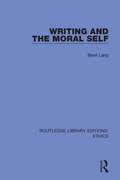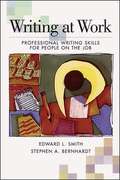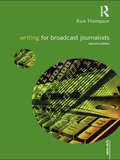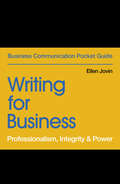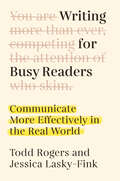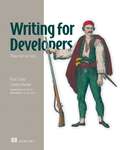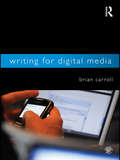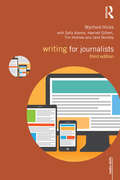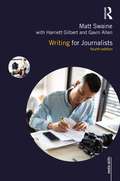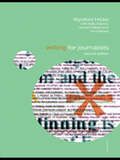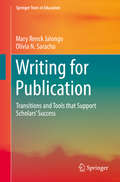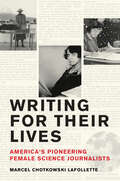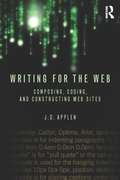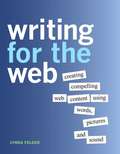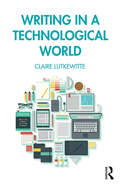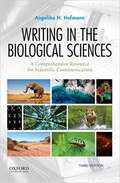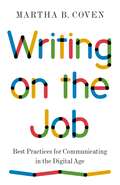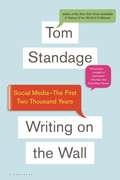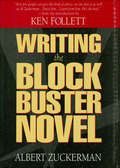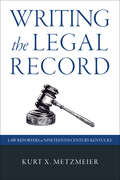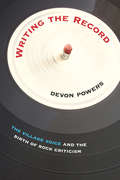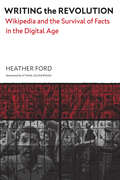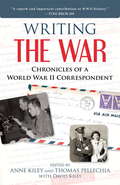- Table View
- List View
Writing and the Moral Self
by Berel LangOriginally published in 1991, this book analyses the relation between writing and ethics in a number of social contexts – in politics, as language discloses its connections to the institutions of totalitarianism and democracy; in the university, as contemporary scholarly ideals find an uncomfortably accurate representation in the stylistic forms of academic writing; in daily social practice, ranging from the status of truth in journalistic writing to the connection between pronouns and affirmative action; and finally in the ethical structure of language itself.
Writing at Work: Professional Writing Skills for People on the Job
by Edward L. Smith Stephen A. BernhardtWriting at Work's for people who do or will write while on the job whether the writing be an interoffice memo, e-mail, a status report, a lab report, marketing materials, or a letter to a customer. The philosophy behind Writing at Work's that such writing needn't be stale and unoriginal but can instead be a sophisticated piece of work that positively reflects the competence of its composer to all who read it. Rather than dwell on picky, little "rules" that you must adhere to when writing, Writing at Work focuses on the real rules of grammar and aspects of style that you really need to know in order to write with confidence. Using examples realistically drawn from work settings, Writing at Work presents each topic in a manner that is at once accessible and inviting. Spread throughout the text are exercises that provide you with ample opportunity to write, revise, and correct the kinds of written tasks typically encountered at work. You can immediately gauge your progress by checking your work against the answers listed at the end of each chapter.
Writing for Broadcast Journalists (Media Skills)
by Rick Thompson'This is a superb book which combines the rare mixture of high quality information with humour. The style of writing engages the reader from the introduction and the experience and insight of the author occasionally makes it difficult to put down, a rare feature of a textbook. I would unreservedly recommend this book not only to those studying journalism but to students of language and all who use the spoken and written word as the ‘materials’ of their work.' Barry Turner, Nottingham Trent University 'Rick Thompson's guidance manual is packed with advice to would-be writers for this medium. He's someone with years of experience at the top level of the national and international profession, and he's smack up to date with his references. The book is aimed at journalists, but anyone with a serious interest in developing their literacy will learn a lot about professional writing skills from what he has to say.' Roy Johnson, www.mantex.co.uk Writing for Broadcast Journalists guides readers through the significant differences between the written and the spoken versions of journalistic English. It will help broadcast journalists at every stage of their careers to avoid such pitfalls as the use of newspaper-English, common linguistic errors, and Americanised phrases, and gives practical advice on accurate terminology and pronunciation, while encouraging writers to capture the immediacy of the spoken word in their scripts. Writing for Broadcast Journalists includes: practical tips on how to avoid ‘journalese’, clichés and jargon guidance on tailoring your writing style to suit a particular audience advice on converting agency copy into spoken English writing to television pictures examples of scripts from some of the best in the business an appendix of ‘dangerous’ words and phrases to be avoided in scripts.
Writing for Business: Professionalism, Integrity & Power
by Ellen JovinBuild essential skills and write with confidence at work! Immediately practical guide to better business writing designed to help you develop a clear, direct, natural communication style that supports rather than obscures what you want to say. Writing for Business covers writing principles that are relevant for a wide range of business documents, including email, letters, memos, reports, proposals, and more, while also offering editing tips to ensure you come across as professional and polished. The book features examples and tips straight from the workplace.
Writing for Business: Professionalism, Integrity & Power (Business Communication Pocket Guides)
by Ellen JovinBuild essential skills and write with confidence at work! Immediately practical guide to better business writing designed to help you develop a clear, direct, natural communication style that supports rather than obscures what you want to say. It covers writing principles relevant for a wide range of business documents, including email, letters, memos, reports, proposals, and more, while also offering editing tips to ensure you come across as professional and polished. Packed with examples and tips straight from the workplace.
Writing for Busy Readers: Communicate More Effectively in the Real World
by Todd Rogers Jessica Lasky-FinkWriting well is for school. Writing effectively is for life. Todd Rogers and Jessica Lasky-Fink offer the most valuable practical writing advice today. Building on their own research in behavioral science, they outline cognitive facts about how people actually read and distill them into six principles that will transform the power of your writing: Less is moreMake reading easyDesign for easy navigationUse enough formatting, but no moreTell readers why they should careMake responding easyIncluding many real-world examples, a checklist and other tools, this guide will make you a more successful and productive communicator. Rogers and Lasky-Fink bring Strunk and White&’s core ideas into the twenty-first century&’s attention marketplace. When the influential guides to writing prose were written, the internet hadn&’t been invented. Now, the average American adult is inundated with digital messages each day. With all this correspondence, capturing a busy reader&’s attention is more challenging than ever. This is how to do it.
Writing for Developers: Blogs that get read
by Piotr Sarna Cynthia DunlopPragmatic methods for writing blogs, articles, and other technical pieces that stand out from the crowd!Do you want to connect with your community, share your state-of-the-art achievements, and help your peers benefit from your hard-fought lessons learned? Do you want to get the kind of attention that expands your career? Master the art of writing engineering blog posts and articles! This comprehensive guide shows you how to create content your fellow developers will love to read and share. Writing for Developers is full of the practical tips, tricks, and techniques you need to translate the ideas floating around your head into content that&’s clear and compelling, including how to: • Pinpoint topics that make intriguing posts • Apply popular blog post design patterns • Rapidly plan, draft, and optimize blog posts • Make your content clearer and more convincing to technical readers • Tap AI for revision while avoiding misuses and abuses • Increase the impact of all your technical communications Whether you&’re brand new to writing, or a seasoned hand who wants more attention for your work, Writing for Developers will help ensure your writing resonates with readers. This isn&’t a generic writing guide—from start to finish, the book is laser-focused on technical topics, writers, and audiences. Authors Piotr Sarna and Cynthia Dunlop combine their differing perspectives as an engineer and professional writer to help you write compelling works. You&’ll learn through detailed examples, methodical strategies, and a &“punk rock DIY attitude!&” Foreword by Bryan Cantrill. Afterword by Scott Hanselman. About the technology A well-crafted technical article can spark a new idea, demystify a technology, expand your perspective, or save you from going down a disastrous path. Even if you don&’t consider yourself a &“good writer,&” you can make a difference by sharing insights and advancing the community. This practical guide shows you how to create blogs, articles, and other content your fellow developers will want to read and share. About the book Writing for Developers introduces seven popular patterns for modern engineering blogs—such as &“The Bug Hunt,&” &“We Rewrote It in X,&” and &“How We Built It&”—and helps you match these patterns with your ideas. This book covers the entire writing process, from brainstorming, planning, and revising, to promoting your blog in ways that build reputation and generate further opportunities. What's inside • Rapidly plan, draft, and review your content • Build on popular blog post design patterns • Support your writing with AI • Increase the impact of all your communications About the reader For developers and engineers of all ability levels—even if you&’re not a native English speaker and never took a writing class in your life. About the author Piotr Sarna is a software engineer and an experienced book and blog author. Cynthia Dunlop has been writing for and with developers for 20+ years.
Writing for Digital Media
by Brian CarrollWriting for Digital Media teaches students how to write effectively for online audiences--whether they are crafting a story for the website of a daily newspaper or a personal blog. The lessons and exercises in each chapter help students build a solid understanding of the ways that the Internet has introduced new opportunities for dynamic storytelling as digital media have blurred roles of media producer, consumer, publisher and reader. Using the tools and strategies discussed in this book, students are able to use their insights into new media audiences to produce better content for digital formats and environments. Fundamentally, this book is about good writing--clear, precise, accurate, filled with energy and voice, and aimed directly at an audience. Writing for Digital Media also addresses all of the graphical, multimedia, hypertextual and interactive elements that come into play when writing for digital platforms. Learning how to achieve balance and a careful, deliberate blend of these elements is the other primary goal of this text. Writing for Digital Media teaches students not only how to create content as writers, but also how to think critically as a site manager or content developer might about issues such as graphic design, site architecture, and editorial consistency. By teaching these new skill sets alongside writing fundamentals, this book transforms students from writers who are simply able to post their stories online into engaging multimedia, digital storytellers. For additional resources and exercises, visit the Companion Website for Writing for Digital Media at: www.routledge.com/textbooks/9780415992015.
Writing for Impact: 8 Secrets from Science That Will Fire Up Your Readers’ Brains
by Bill BirchardLearn the keys to energizing your writing, engaging readers, and breaking out with influence.What good will it do to skillfully craft a written argument if you lose your audience? Simple emails, formal reports, blogs, presentations, articles—they need punch to gain influence. Clear structure and logic alone won&’t do. To engage readers, you need to make mentally stimulating choices in language—choices that electrify your readers&’ mental hotspots.Veteran journalist Bill Birchard reveals the secret of making that happen. He blends the findings from a global cadre of psychologists and neuroscientists with lessons from his long, successful career as a professional writer. In Writing for Impact, he details eight potent writing strategies, based on the latest scientific breakthroughs, to give you the power to write faster, win over more people, and earn influence as a thought leader.As a reader, you will:Discover the story of recent scientific research that shows how the right language rewards readers mentally, engaging them with hits of dopamine and more.Learn the eight time-tested writing strategies—strategies you can apply immediately—to become a better, more impactful writer and communicator.Learn three dozen tactics to hook readers with each strategy, tactics proven to work based on how the brain processes language and meaning.Find engaging writing examples to illustrate each strategy and inspire you to write with punch that keeps your audience coming back for more.Master the eight-part strategic framework step by step, giving yourself a methodical means to develop yourself into a writer who communicates like a pro.
Writing for Journalists (Media Skills)
by Tim Holmes Adams Sally Harriett Gilbert Wynford Hicks Jane BentleyThe new edition of Writing for Journalists focuses on the key issue for writers working across all forms of media today: how to produce clear, engaging and illuminating copy that will keep the reader hooked from start to finish. Written by skilled specialist contributors and drawing on a broad range of examples to illustrate the best professional practice, this edition includes: chapters on how to write news, features and reviews whatever the format used for delivery expanded chapters on writing for digital publication in both shortform and longform top tips on writing columns and blogs from leading professionals an exploration of the importance of style and its impact on great journalistic writing an extensive glossary of terms used in journalism and suggestions for further reading This is an essential guide to good writing for all practising journalists and students of journalism.
Writing for Journalists (Media Skills)
by Harriett Gilbert Matt Swaine Gavin AllenThoroughly revised and updated, the fourth edition of Writing for Journalists focuses on the craft of journalistic writing, offering invaluable insight on how to hook readers and keep them to the end of your article. The book offers a systematic approach to news and feature writing that starts with the basics and builds to more complex and longer pieces. The authors give the reader the tools they need to deliver engaging and authoritative writing that works across print and digital. Drawing on professional insight from writers across the industry, the book guides readers through the essential elements needed to write powerful and effective news stories, from hard news pieces to features on business, science, travel and entertainment reviews. New to this edition are hands-on writing exercises accompanying each chapter to help reinforce key points; chapters on how to build a professional profile, pitch stories and get commissioned; and a section on online writing, SEO, analytics and writing for social media. This is an essential guide for all journalism students and early-career journalists. It also has much to offer established journalists looking to develop their writing and lead editorial teams.
Writing for Journalists (Media Skills)
by Tim Holmes Sally Adams Harriett Gilbert Wynford HicksPraise for the first edition: 'There are books that are badly written, books that are well written and books that you wish you'd written. This is one of the latter. Hicks and his co-writers produce a book that is a joy to read and is packed full of helpful advice.' - Chris Frost, Journalist 'You don't have to be a journalist to read this book. Anyone with an interest in improving their writing skills and developing a sense of good style will find it useful Wynford Hicks takes a no-nonsense, sleeves rolled up approach to writing which has no time for preciousness.' - Roy Johnson, Mantex'Writing for Journalists neatly fills a gap in the market for a no-nonsense book for trainees written by trainers who genuinely understand the industry and who have moved with the times.' - Sharon Wheeler, Journalism Studies Writing for Journalists is about the craft of journalistic writing: how to put one word after another so that the reader gets the message - or the joke - goes on reading and comes back for more. It is a practical guide for all those who write for newspapers, periodicals and websites, whether students, trainees or professionals. This revised and updated edition introduces the reader to the essentials of good writing. Based on critical analysis of news stories, features and reviews from daily and weekly papers, consumer magazines, specialist trade journals and a variety of websites, Writing for Journalists includes: advice on how to start writing and how to improve and develop your style how to write a news story which is informative, concise and readable tips on feature writing from researching profiles to writing product round-ups how to structure and write reviews a new chapter on writing online copy.
Writing for Publication
by Mary Renck Jalongo Olivia N. SarachoThis book offers systematic instruction and evidence-based guidance to academic authors. It demystifies scholarly writing and helps build both confidence and skill in aspiring and experienced authors. The first part of the book focuses on the author's role, writing's risks and rewards, practical strategies for improving writing, and ethical issues. Part Two focuses on the most common writing tasks: conference proposals, practical articles, research articles, and books. Each chapter is replete with specific examples, templates to generate a first draft, and checklists or rubrics for self-evaluation. The final section of the book counsels graduate students and professors on selecting the most promising projects; generating multiple related, yet distinctive, publications from the same body of work; and using writing as a tool for professional development. Written by a team that represents outstanding teaching, award-winning writing, and extensive editorial experience, the book leads teacher/scholar/authors to replace the old "publish or perish" dictum with a different, growth-seeking orientation: publish and flourish.
Writing for Their Lives: America’s Pioneering Female Science Journalists
by Marcel Chotkowski LaFolletteA breathtaking history of America&’s trail-blazing female science journalists—and the timely lessons they can teach us about equity, access, collaboration, and persistence.Writing for Their Lives tells the stories of women who pioneered the nascent profession of science journalism from the 1920s through the 1950s. Like the &“hidden figures&” of science, such as Dorothy Vaughan and Katherine Johnson, these women journalists, Marcel Chotkowski LaFollette writes, were also overlooked in traditional histories of science and journalism. But, at a time when science, medicine, and the mass media were expanding dramatically, Emma Reh, Jane Stafford, Marjorie Van de Water, and many others were explaining theories, discoveries, and medical advances to millions of readers via syndicated news stories, weekly columns, weekend features, and books—and they deserve the recognition they have long been denied.Grounded in extensive archival research and enlivened by passages of original correspondence, Writing for Their Lives addresses topics such as censorship, peer review, and news embargoes, while also providing intimate glimpses into the personal lives and adventures of mid-twentieth-century career women. They were single, married, or divorced; mothers with child-care responsibilities; daughters supporting widowed mothers; urban dwellers who lived through, and wrote about, the Great Depression, World War II, and the dawn of the Atomic Age—all the while, daring to challenge the arrogance and misogyny of the male scientific community in pursuit of information that could serve the public.Written at a time when trust in science is at a premium, Writing for Their Lives is an inspiring untold history that underscores just how crucial dedicated, conscientious journalists are to the public understanding and acceptance of scientific guidance and expertise.
Writing for the Web: Composing, Coding, and Constructing Web Sites
by J. D. ApplenWriting for the Web unites theory, technology, and practice to explore writing and hypertext for website creation. It integrates such key topics as XHTML/CSS coding, writing (prose) for the Web, the rhetorical needs of the audience, theories of hypertext, usability and architecture, and the basics of web site design and technology. Presenting information in digestible parts, this text enables students to write and construct realistic and manageable Web sites with a strong theoretical understanding of how online texts communicate to audiences. Key features of the book include: Screenshots of contemporary Web sites that will allow students to understand how writing for and linking to other layers of a Web site should work. Flow charts that describe how Web site architecture and navigation works. Parsing exercises in which students break down information into subsets to demonstrate how Web site architecture can be usable and scalable. Detailed step-by-step descriptions of how to use basic technologies such as file transfer protocols (FTP). Hands-on projects for students to engage in that allow them to connect the various components in the text. A companion website with downloadable code and additional pedagogical features: www.routledge.com/cw/applen ? Writing for the Web prepares students to work in professional roles, as it facilitates understanding of architecture and arrangement of written content of an organization’s texts.
Writing for the Web: Creating Compelling Web Content Using Words, Pictures and Sound
by Lynda FelderWith Writing for the Web, you'll learn everything you need to know to create effective Web content using words, pictures, and sound. Follow along as instructor and writer Lynda Felder combines easy-to-follow guidelines with photographs, lists, and tables to illustrate the key concepts behind writing nonlinear, interactive stories; creating succinct and clear copy; and working compelling images, motion graphics, and sound into your content.
Writing in a Technological World
by Claire LutkewitteWriting in a Technological World explores how to think rhetorically, act multimodally, and be sensitive to diverse audiences while writing in technological contexts such as social media, websites, podcasts, and mobile technologies. Claire Lutkewitte includes a wealth of assignments, activities, and discussion questions to apply theory to practice in the development of writing skills. Featuring real-world examples from professionals who write using a wide range of technologies, each chapter provides practical suggestions for writing for a variety of purposes and a variety of audiences. By looking at technologies of the past to discover how meanings have evolved over time and applying the present technology to current working contexts, readers will be prepared to meet the writing and technological challenges of the future. This is the ideal text for undergraduate and graduate courses in composition, writing with technologies, and professional/business writing. A supplementary guide for instructors is available at www.routledge.com/9781138580985
Writing in the Biological Sciences: A Comprehensive Resource for Scientific Communication
by Angelika HofmannPractical and easy to use, Writing in the Biological Sciences: A Comprehensive Resource for Scientific Communication, Third Edition, presents students with all of the techniques and information they need to communicate their scientific ideas, insights, and discoveries. <p><p>Angelika H. Hofmann introduces students to the underlying principles and guidelines of professional scientific writing and then teaches them how to apply these methods when composing essential forms of scientific writing and communication. Ideal as a free-standing textbook for courses on writing in the biological sciences or as reference guide in laboratories, this indispensable handbook gives students the tools they need to succeed in their undergraduate science careers and beyond.
Writing on the Job: Best Practices for Communicating in the Digital Age
by Martha B. CovenA practical and compact guide to writing for professionalsWriting is an essential skill in today’s workplace. From messaging platforms and social media to traditional forms of communication like memos and reports, we rely on words more than ever. Given how much reading we do on mobile devices, being able to write succinctly is critical to success. Writing on the Job is an incisive guide to clear and effective writing for professionals.Martha Coven begins with the basics, explaining how to develop a professional style, get started on a piece of writing, create a first draft, and edit it into a strong final product. She then offers practical advice on more than a dozen forms of writing, from emails and slide decks to proposals and cover letters. Along the way, Coven provides a wealth of concrete examples and simple templates that make the concepts easy to understand and apply.Based on Coven’s popular writing classes and workshops at Princeton University as well as her decades of experience in the public and private sectors, Writing on the Job addresses the real challenges professionals face in today’s digital age, and shares essential practices that can improve the performance of any organization.
Writing on the Wall: Social Media--The First 2,000 Years
by Tom StandageThe Catholic Church's dilemmas in responding to Martin Luther's attacks are similar to those of today's large institutions in responding to criticism on the Internet, for example, and seventeenth-century complaints about the distractions of coffeehouses mirror modern concerns about social media. Invoking figures from Thomas Paine to Vinton Cerf, co-inventor of the Internet, Standage explores themes that have long been debated, from the tension between freedom of expression and censorship to social media's role in spurring innovation and fomenting revolution.
Writing the Blockbuster Novel
by Al ZuckermanEvery novelist dreams of it--writing the book that rockets to the top of the best-seller lists. Now, they can see how it's done, up close, in a book by an agent who has sold manuscripts that turned into hits.<P><P> Here Albert Zuckerman covers the essential elements of the blockbuster novel and shows writers how to put them to work in their books. Zuckerman covers the subject thoroughly, from creating outlines and building larger than life characters to injecting suspense and more. His instruction is decisive, direct and clear and is supported with examples from Gone With the Wind, The Godfather and other blockbusters.
Writing the Legal Record: Law Reporters in Nineteenth-Century Kentucky
by Kurt X. Metzmeier“Deft sketches of 13 substantial actors in Kentucky’s early history who also happened to have reported appellate cases. They are brought to life.” —Kentucky Bench & BarAny student of American history knows of Washington, Jefferson, and the other statesmen who penned the documents that form the legal foundations of our nation, but many other great minds contributed to the development of the young republic’s judicial system—figures such as William Littell, Ben Monroe, and John J. Marshall. These men, some of Kentucky’s earliest law reporters, are the forgotten trailblazers who helped establish the foundation of the state’s court system.In Writing the Legal Record: Law Reporters in Nineteenth-Century Kentucky, Kurt X. Metzmeier provides portraits of the men whose important yet understudied contributions helped create a new common law inspired by English legal traditions but fully grounded in the decisions of American judges. He profiles individuals such as James Hughes, a Revolutionary War veteran who worked as a legislator to reform confusing property laws inherited from Virginia. Also featured is George M. Bibb, a prominent US senator and the secretary of the treasury under President John Tyler.To shed light on the pioneering individuals responsible for collecting and publishing the early opinions of Kentucky’s highest court, Metzmeier reviews nearly a century of debate over politics, institutional change, human rights, and war. Embodied in the stories of these early reporters are the rich history of the Commonwealth, the essence of its legal system, and the origins of a legal print culture in America.“Kurt Metzmeier’s fine study of the Kentucky court system helps fill in many gaps in our historical knowledge.” —Ohio Valley History
Writing the Record: The Village Voice and the Birth of Rock Criticism
by Devon PowersDuring the mid-1960s, a small group of young journalists made it their mission to write about popular music, especially rock, as something worthy of serious intellectual scrutiny. Their efforts not only transformed the perspective on the era's music but revolutionized how Americans have come to think, talk, and write about popular music ever since. In Writing the Record, Devon Powers explores this shift by focusing on The Village Voice, a key publication in the rise of rock criticism. Revisiting the work of early pop critics such as Richard Goldstein and Robert Christgau, Powers shows how they stood at the front lines of the mass culture debates, challenging old assumptions and hierarchies and offering pioneering political and social critiques of the music. Part of a college-educated generation of journalists, Voice critics explored connections between rock and contemporary intellectual trends such as postmodernism, identity politics, and critical theory. In so doing, they became important forerunners of the academic study of popular culture that would emerge during the 1970s. Drawing on archival materials, interviews, and insights from media and cultural studies, Powers not only narrates a story that has been long overlooked but also argues that pop music criticism has been an important channel for the expression of public intellectualism. This is a history that is particularly relevant today, given the challenges faced by criticism of all stripes in our current media environment. Powers makes the case for the value of well-informed cultural criticism in an age when it is often suggested that "everyone is a critic."
Writing the Revolution: Wikipedia and the Survival of Facts in the Digital Age
by Heather FordA close reading of Wikipedia&’s article on the Egyptian Revolution reveals the complexity inherent in establishing the facts of events as they occur and are relayed to audiences near and far.Wikipedia bills itself as an encyclopedia built on neutrality, authority, and crowd-sourced consensus. Platforms like Google and digital assistants like Siri distribute Wikipedia&’s facts widely, further burnishing its veneer of impartiality. But as Heather Ford demonstrates in Writing the Revolution, the facts that appear on Wikipedia are often the result of protracted power struggles over how data are created and used, how history is written and by whom, and the very definition of facts in a digital age. In Writing the Revolution, Ford looks critically at how the Wikipedia article about the 2011 Egyptian Revolution evolved over the course of a decade, both shaping and being shaped by the Revolution as it happened. When data are published in real time, they are subject to an intense battle over their meaning across multiple fronts. Ford answers key questions about how Wikipedia&’s so-called consensus is arrived at; who has the power to write dominant histories and which knowledges are actively rejected; how these battles play out across the chains of circulation in which data travel; and whether history is now written by algorithms.
Writing the War
by Anne Kiley Thomas Pellechia David KileyAs expansive as it is personal, this chronicle of World War II is a firsthand account by a journalist and the woman he would marry of the dramatic events that engulfed the world in the middle of the twentieth century. The correspondence between Charles Kiley and Billee Gray also tells the poignant tale of two young people in love but forced apart by the circumstances of war. Edited by Charles and Billee's daughter, son, and son-in-law, this never-before-published compilation of letters is a striking example of the heroic, call-to-duty spirit that characterized "the greatest generation. " Charles was a soldier-journalist for the U. S. Army's Stars and Stripes newspaper and reported on the war from London, Normandy, Paris, Reims, Belgium, and Germany. As the sole reporter allowed direct access to Eisenhower's staff, he was the only reporter on the scene when the German high command was negotiating its unconditional surrender on May 7, 1945. Among his army newspaper friends and colleagues was Andy Rooney, later CBS correspondent and 60 Minutes commentator. Billee, like many young women of her time, witnessed the war years from the home front and filled vital civilian roles-defense-industry plant worker, Red Cross volunteer, war bonds salesgirl, and civil defense plane-spotter-and wrote about it all in her letters to Charles. Peppered with fascinating details about soldiers' and civilians' lives, and including Stars and Stripes articles and personal photographs of the era, Writing the War is both important history and a tribute to two remarkable people as well as their extraordinary generation.
